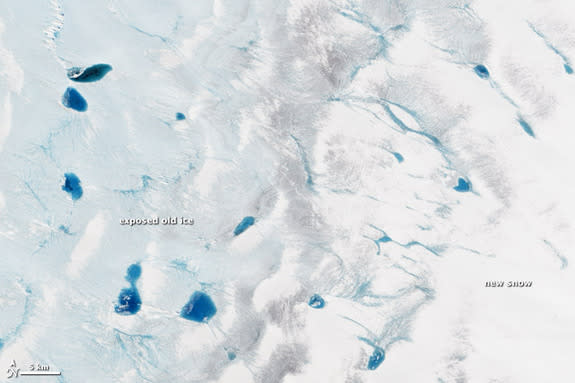Summer Melt Begins in Greenland

As spring and summer bring the sun's rays back to the Arctic after the long, dark winter, the ice on the surface of the Greenland Ice Sheet begins its annual melt, pooling in depressions on the icy expanse that dot the ice with brilliant shades of blue.
Scientists study these melt ponds to get an idea of the rate of melting of the ice sheet as a whole and how that might affect the flow of its glaciers out to sea, as meltwater that trickles down between the ice and the bedrock below it helps lubricate the ice.
One of the ways scientists can monitor the melt ponds is by satellite images. An image taken by the Operational Land Imager on the Landsat 8 satellite on June 21 shows that 2013's melt is "well under way," according to NASA's Earth Observatory. The satellite can measure light in blue wavelengths that penetrate into the water more deeply than other wavelengths, which means it can see all the way to the bottom of the ponds, the Earth Observatory explained.
The satellite measurements can tell scientists the depth of a pond and the purity of the water inside it. In combination with measurements made on the surface of the ice sheet itself and airborne lidar, or laser-light-based radar, scientists can get a better picture of the extent of melt on the ice sheet.
Melt ponds can create a cycle of melt on the ice sheet's surface because it changes the amount of sunlight the ice absorbs. While new ice and snow reflect light back to space, older ice below the surface that is exposed by melt is up to 30 percent less reflective, the Earth Observatory says, and meltwater absorbs the sun's rays.
While the 2013 spring/summer melt was slow to start, it has proceeded rapidly, at a pace that is faster than the average melt from 1981 to 2010. Whether or not the 2013 melt will match the record-setting melt seen in 2012 isn't yet known, since the peak in melting has yet to occur, Mahsa Moussavi, a Ph.D. student at the University of Colorado told the Earth Observatory. Last year, the cumulative melt on the ice sheet was the most seen in 30 years of record-keeping, and in mid-July, nearly the entire veneer of ice coating the ice sheet's surface melted.
Follow Andrea Thompson @AndreaTOAP, Pinterest and Google+. Follow us @livescience, Facebook & Google+. Original article on LiveScience.com.
Copyright 2013 LiveScience, a TechMediaNetwork company. All rights reserved. This material may not be published, broadcast, rewritten or redistributed.

